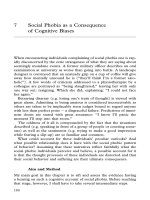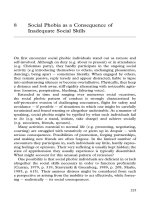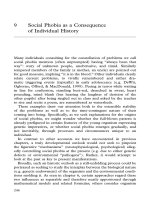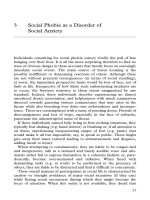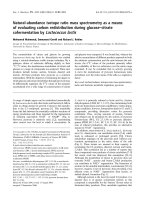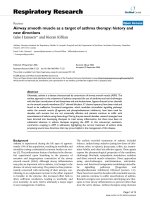Elders engaged in begging as a means of livelihood in debre birhan town an exploration of major push factors and their challenges
Bạn đang xem bản rút gọn của tài liệu. Xem và tải ngay bản đầy đủ của tài liệu tại đây (1.32 MB, 91 trang )
i
Exploration of Major Push Factors and Challenges of Elder Beggars
Elders engaged in begging as a means of livelihood in Debre Birhan town: An
exploration of major push factors and their challenges
By: Aynshet Wendosen
A Thesis Submitted to School of Social work in Partial Fulfillment of the
Requirements for the Degree of Master of Social Work (MSW)
Addis Ababa University
School of Social Work
June, 2017
Addis Ababa, Ethiopia
Exploration of Major Push Factors and Challenges of Elder Beggars
ii
Addis Ababa University
School of Social Work
Elders engaged in begging as a means of livelihood in Debre Birhan town: An
exploration of major push factors and challenges
A Thesis Submitted to School of Social work in Partial Fulfillment of the
Requirements for the Degree of Master of Social Work (MSW)
By: Aynshet Wendosen
Advisor: Meseret Kassahun (PhD)
June, 2017
Addis Ababa. Ethiopia
Exploration of Major Push Factors and Challenges of Elder Beggars
iii
Declaration
I, the undersigned, declare that this master’s thesis is my original work and all the
sources or materials used have been duly acknowledged.
Name
Aynshet Wendosen
Signature
________________
Date
________________
Advisor’s Approval
This Master’s thesis has been submitted for examination with my approval as a
university advisor.
Name
Meseret Kassahun (PhD)
Signature
________________
Date
________________
iv
Exploration of Major Push Factors and Challenges of Elder Beggars
Thesis Submitted to School of Social Work in Partial Fulfillment of the
Requirements for the Degree of Master of Social Work (MSW)
By: Aynshet Wendosen
Approved by Examining Board
__________________
__________________
Advisor
Signature
__________________
__________________
Internal Examiner
Signature
__________________
__________________
External Examiner
Signature
__________________
Date
__________________
Date
__________________
Date
Exploration of Major Push Factors and Challenges of Elder Beggars
v
Acknowledgements
Above all, my greatest thanks go to the Almighty God for His unreserved assistance, giving me
the strength and the energy throughout the research process and his continuous blessing upon my
life. Then, My special thanks goes to my advisor Dr. Meseret Kassahun for her valuable and
constructive comments, guidance and follow up from the initial and in each stage until the end
of this study. In addition to these, her encouragement and respectfulness assisted me to complete
the study on due time and in organizing the thesis into its present form. Further would also give
thanks to Debre Birhan town elder beggars for taking time off to provide valuable information to
conduct this thesis.
Exploration of Major Push Factors and Challenges of Elder Beggars
vi
Definition of Terms and Concepts
Begging: is defined as an act of asking alms that is essential for survival, solving temporary
problems or fulfilling some crucial and religious assurances (MoLSA, 1992).
Beggar: a person who lives by asking people for money or food.
Disability status: refers to difficulty in carrying out tasks of daily life. The person can’t take
care of him or herself. It is any loss of normal physical abilities due to illness, or injury or
accident.
Elder: refers to a category of adults who have attained advanced ages, 60 or 65 years. Ethiopia
uses 60 years and above to refer the elderly (United Nation, 2010). According to this study elders
are those people whose age is 60 years and over.
Elder beggars: refer for this study those whose age ranges from 60 and above who practices
begging on the defined site.
Livelihood: in this study is taken as a source of income or the income itself. This includes cash
and non-cash income.
Poverty: Poverty in its most general sense is the lack of necessities such as basic food, shelter,
Livelihood strategy: is a way, tactic or approach to generate income needed to meet human
needs.
Exploration of Major Push Factors and Challenges of Elder Beggars
vii
Abstract
This study explored that the push factors, challenges and coping mechanisms of elder beggars in
Debrebirhan town. Qualitative descriptive case study design is employed to come up with the
detailed understanding of the issue under investigation. Multiple data sources which include indepth interview, focus group discussion and observation are used to generate adequate data. The
study employed purposive sampling methods in order to incorporate participants based on predetermined criteria. Thematic types of data analysis is used to categorize and labeled ideas in to
meaningful themes from which meaningful interpretation emerged. The analysis of the study
passed through the process of transcribing, translating, categorizing, thematizing and
interpreting. According to the findings of the study the major push factors of elder beggars to
engage in begging were death and distance of support providers, disengagement from work,
economic, family, environmental, physical and health problems. The finding of the study also
showed the challenges of elder beggars. Elder beggars encounter challenges in getting food and
cloth, house, problem of health, physical and psychological challenges. They cope those
challenges by cutting meal, by drying bulle, buying cheapest food, some of them by drinking
local areke, Self-medication, eating garlic, reporting the police, sharing feelings, adapting the
situation and using religious practices. Implication for social work practice, policy and future
research also suggested that social workers can play the role of intervention through
advocating, counseling for the study participants, work in the formulation as well as
suggestion of policy based on the finding of the study and also further investigation should
conduct by including elder beggars in different regions of the country.
Key words: Elder Beggars, Push Factors, Challenges, Coping Strategies
Exploration of Major Push Factors and Challenges of Elder Beggars
viii
Table of Contents
Acknowledgements ....................................................................................................................................... v
Definition of Terms and Concepts ............................................................................................................... vi
Abstract ........................................................................................................................................................vii
List of Abbreviations ....................................................................................................................................xi
List of Figure.................................................................................................................................................xi
List of Tables ................................................................................................................................................xi
Chapter One .................................................................................................................................................. 1
Introduction ................................................................................................................................................... 1
Background of the Study........................................................................................................................... 1
Statement of Problem ................................................................................................................................ 4
Objective ................................................................................................................................................... 6
General objective .................................................................................................................................. 6
Specific objectives ................................................................................................................................ 7
Research Questions ................................................................................................................................... 7
Significance of the Study .......................................................................................................................... 7
Limitations of the Research ...................................................................................................................... 8
Chapter Two.................................................................................................................................................. 9
Literature Review.......................................................................................................................................... 9
Definition of begging ............................................................................................................................ 9
Historical background of begging ......................................................................................................... 9
The situation of begging in Ethiopia ................................................................................................... 11
Factors for Begging............................................................................................................................. 11
The challenges of beggars ................................................................................................................... 17
Coping mechanism of beggars ............................................................................................................ 20
Theoretical Framework ........................................................................................................................... 21
Chapter Three.............................................................................................................................................. 26
Methodology ............................................................................................................................................... 26
Exploration of Major Push Factors and Challenges of Elder Beggars
ix
Paradigm ................................................................................................................................................. 26
Research Design...................................................................................................................................... 27
Selection of Study Participants ............................................................................................................... 30
Data collection methods .......................................................................................................................... 30
Data Collection Procedures..................................................................................................................... 32
Data Analysis .......................................................................................................................................... 33
Ensuring the Trustworthiness of Data ..................................................................................................... 33
Protection of Human subjects ................................................................................................................. 34
Chapter Four ............................................................................................................................................... 36
Findings ...................................................................................................................................................... 36
Introduction ............................................................................................................................................. 36
Profiles of Study Participant ................................................................................................................... 36
Push Factors for Elders to Engage in Begging ....................................................................................... 38
Economic problem .............................................................................................................................. 38
Family problems ................................................................................................................................. 39
Death and distance of support providers ............................................................................................. 41
Disengagement from work .................................................................................................................. 42
Physical and health problems .............................................................................................................. 43
Environmental problems ..................................................................................................................... 44
Elder Beggar’s challenges....................................................................................................................... 45
Challenges in getting food and clothing ............................................................................................. 45
House challenge .................................................................................................................................. 46
Health challenges ................................................................................................................................ 48
Psychological and physical challenges ............................................................................................... 51
Elder Beggars’ Coping Strategies for their challenges ........................................................................... 54
Cutting meals and drying food ............................................................................................................ 54
Eating cheaper food ............................................................................................................................ 55
Drinking local areke ........................................................................................................................... 56
Religious practices .............................................................................................................................. 56
Self-medication ................................................................................................................................... 57
Exploration of Major Push Factors and Challenges of Elder Beggars
x
Using garlic ......................................................................................................................................... 58
Adapting the situation ......................................................................................................................... 58
Reports to the police ........................................................................................................................... 58
By sharing feelings ............................................................................................................................. 59
Chapter Five ................................................................................................................................................ 61
Discussion ................................................................................................................................................... 61
Push factors to Engage in Begging ......................................................................................................... 61
Elder Beggar’s Challenges ...................................................................................................................... 63
Elder Beggar’s Coping Strategies for Their Challenges ......................................................................... 66
Chapter Six.................................................................................................................................................. 68
Conclusion and Implication for Social Work ............................................................................................. 68
Conclusions ............................................................................................................................................. 68
Implication to Social Work ..................................................................................................................... 70
Implications for social work practice .................................................................................................. 70
Implication for policy.......................................................................................................................... 72
Implication for future research ............................................................................................................ 73
Reference .................................................................................................................................................... 74
Appendices/Annexes................................................................................................................................... 77
Annex I: Consent form............................................................................................................................ 77
Annex II: Guiding Question for in Depth Interview Participant ............................................................ 78
Annex III: FGD Guiding Question for Study Participant. ...................................................................... 79
Annex IV: Observation checklist ............................................................................................................ 79
Exploration of Major Push Factors and Challenges of Elder Beggars
List of Abbreviations
MOLSA
Ministry of Labor and Social Affairs
ILO
International Labour Organization
HAI
Help Age International
NGO
Non-Governmental Organization
CSA
Central Statics Agency
NASW
National Social Work Association.
FGD
Focus group discussion
ERDA
Elshadai relief and development association
ANRS
Amhara national regional state
EB
Elder beggar
FEB
Focus group elder beggars
UN
united nation
List of Figure
Fig1: population pyramid (source: UN 2011)
Fig2: Map of the study area (debrebirhan town)
Fig3: elder beggars sleeping on the street
Fig4: elder beggars drying their bulle
List of Tables
Table1: Elder beggar’s participants for in-depth interview
Table 2: observation check lists
xi
Exploration of Major Push Factors and Challenges of Elder Beggars
1
Chapter One
Introduction
This chapter included the background, statement of the problem, significance of the study,
study objective, research questions, and limitation of the research.
Background of the Study
Begging is one of the social problems in a certain country or across the world that
involves various activities through which an individual requests fellow community members
or strangers for money, food or other resources on the basis of being poor or needing
charitable donation for basic survival, health or religious reason (International labour
organization [ILO,2014). Even though it is difficult to get clear and sufficient evidence about
where and when begging started, from different traditional and oral hearsays it is estimated as
it has been started with the emergence of a competitive life (Lucas, 2007). It is believed that
begging has a long history in Ethiopia, but there is no written document that indicates the
exact time and place of its beginning in the country. However, oral reports indicate that
begging has existed for centuries especially around religious temples or synagogue and rural
areas (Ministry of Labor and Social Affairs [MoLSA, 1992).
Today, large numbers of the elderly, the unaccompanied children, mothers and
handicapped soldiers escaped to cities and towns being involved in the practice of begging as
a means of livelihood. It is also taken as the last alternative of coping mechanisms of poverty,
disability and various political, social and environmental crises (MoLSA 2006). There may
be a number of reasons that lead to begging depending on the economic circumstances of a
given country, several factors are repeatedly identified in numerous studies conducted across
a range of countries. Inadequate access for basic necessities such as; inability to secure
housing, clothing, and food are identified as the major factors (Christopher, 2015).
Exploration of Major Push Factors and Challenges of Elder Beggars
2
According to the research conducted by Addis Ababa City Government Labor and
Social Affairs Office (2015) explored that 10,253 peoples are engaged in begging and
among this figure 2,351(22.9 %) were elder beggars found in Addis Ababa.
Elderly can be defined in terms of chronological age, functional age, biological age as
well as the retirement age. In developed countries the life expectancy is high and the age of
retirement from active public economic activity is 65 years, and the elderly age defined as
persons aged 65 years and above. Where as in developing countries the life expectancy is
low and the age of retirement is 60 years. Therefore, the elderly considered as persons aged
60 years and above. Ethiopia accepted the UN definition as it coincides with the countries
official retirement age is 60 years and above (UN, 2011).
As one of the developing countries Ethiopia’s population pyramid shows that the
majority of its population falls under the age of fifteen. According to the triangular structure
(broad base) of the country’s population pyramid also reveals the fact that people aged sixty
four and above are the smallest age group.
Fig1: population pyramid (source: UN 2011)
Exploration of Major Push Factors and Challenges of Elder Beggars
3
The 2007 Ethiopian Housing and Population Census Report of CSA explored that the
number of elderly persons were 3.6 million that constitute around 5% of the total population.
Inadequate clothing, inaccessibility to health service, lack of caregivers, age related health
problems, absence of social welfare provision, psychological stress and trauma associated to
death of their children and grandchildren, and lack of elderly targeted projects are major
problems facing old people (Mussie,2006). It is common to see the elderly who have the
knowledge and skill to help not only themselves but others facing serious problems and
resorting to begging and sleeping in streets (MoLSA, 2006).
Begging is not a matter of choice to these elderly people, it is rather the only mechanism
to cope with their reality where there is no one to support them (Abdi, 2012). The causes of
beggary are multidimensional or vary in accordance with the type of beggars in the past or
present socio-economic, health and other factors or events. Therefore, it is impossible to
attribute one major cause for people’s resort to begging. Hence, the causes for begging can
only be identified through research that takes into account individual cases and those who
have a direct experience (Wubshet, 2003).
Debrebirhan is one of the growing towns in Amhara region. According to the 2015
Population Projection Values at zonal and wereda levels, Debrebirhan Town Administration,
2015-16 by Central Statistical Authority (CSA), found that the town has a population of
92,889 of which 6,032 (6.49%) people are elders. The numbers of elder beggars are
increasing in different time due to different factors. A recent survey by the North Showa
Zone Labor and Social Affairs Bureau (2016) also revealed that 216 beggars are engaged in
begging in this town. Among these beggars 120 of them were 60 and over while the
remaining are below the age of sixty but it doesn’t incorporated children. Begging is
becoming a more serious social issue which rises up from time to time when the elderly
people use it as a means of livelihood in the town. However, the increasing complexity in the
Exploration of Major Push Factors and Challenges of Elder Beggars
4
depth and magnitude of this problem has also given less attention by the concerned bodies in
the study area.
Statement of Problem
Begging is an issue which is not given much attention today especially in the study area.
Older persons are facing various problems which expose them to engage in begging and this
practice becomes a means of livelihood for a large number of persons (Wubshet, 2003).
In Ethiopia, there are a number of researchers conducted studies on different aspects of
begging. A study Undertaken by Tatek (2009) on the survival strategies of Child Beggars in
Addis Ababa city explored about the perspectives of children on begging as a way of life, the
life experiences of children and social and economic significance of begging to poor children.
In addition to this, Abebaw (2003) conducted research on child beggars in Addis Ababa city
and assessed about the psychosocial effects on the behavior of children and the reason for
using children for begging, magnitude of using children for begging, and attitude of people
towards using children for begging
The study conducted by Girmachew (2006) on the livelihoods and survival strategies
among migrant children revealed that elders as well as street children, disabled people, and
families beg in public spaces such as shopping areas, cinema and theater halls, stadiums,
churches, mosques, busy streets or at the junction and near traffic lights, as begging is a
principal means of livelihood. The study focused on migrant children in Addis Ababa city by
using structural theory and livelihood approach employed as a theoretical framework to
address the research problem.
Fireyihun (2011) studied about the experiences of beggars who were practicing begging
and the problem of begging only from mother beggar’s point of view at the age range of 23 to
35, who carried babies while they beg in Addis Ababa city by using semi structured interview
Exploration of Major Push Factors and Challenges of Elder Beggars
5
and observation method of data collection. In addition to this Kerebh et.al (2014) explored
the demographic and socio-economic determinants of women beggars in Bahir Dar town. The
study assessed about the duration of begging practice and reasons for begging among women
beggars in Bahir Dar town by using a case-control design.
The study conducted by International Labour Organization (2014) on disabled beggars in
Addis Ababa showed that begging is more common in urban areas, with the population of
beggars in urban areas drawn from the surrounding countryside, as well as within the cities
themselves, which provide greater anonymity and a broader base for support. In addition to
this Wamisho and Menore (2009) conducted study on begging on the street and tried to
assess about the causes of street begging, the degree and duration begging on the streets as an
impact of musculoskeletal disability in Addis Ababa. The researchers revealed that 1,237
street beggars engaged in begging activity. Fitsum (2009) conducted on the life experience
style of street beggars by considering it as a means of livelihood for elders, children and
youngsters who are found actively engaged in Shashemene town.
Mohammed (2016) conducted study on begging as a means of livelihood for migrants in
Jigjiga town. The researcher explored that significant number of migrants at Jigjiga town
have been engaged in begging by traveling from one individual home to another, but a
number of migrant beggars live a very unhygienic lifestyle, cooking, sleeping and even
release waste in the same area and large proportion of destitute migrant beggars don’t have
access to shelter, medication, either potable water or water for washing and educational
opportunities. However, this study gives more emphasis for young migrant beggars who
came from Eastern Harare Zones.
Wubshet (2003) conducted research on Begging as a Survival Strategy at the Orthodox
Religious Ceremonial Days in Addis Ababa and the author tried to explore the major causes
Exploration of Major Push Factors and Challenges of Elder Beggars
6
to begging as a means of livelihood. This research given emphasis is placed on the
description of begging in the context of the orthodox ceremonial days and participants were
including all age group beggars. But, now a day the number of elder beggars is increasing and
in Debre Birhan town in particular has an impact on the socioeconomic development of the
country. In addition to this, Addis Ababa City Government Office of Labour and social
Affairs (2015) conducted research on the causes and effects of begging in Addis Ababa. The
study considers the participants including all age groups beggars. The study explored that
10,253 beggars were found and among this 2,351(22.9 %) were elder beggars found in Addis
Ababa city. The Bureau of Labor and Social Affairs of North Showa Zone also undertook
few surreys, which aimed at knowing the overall situation of beggars, but it did not try to
identify the basic push factors and challenges of beggars especially elders.
Looking into recent studies, discussed above, the researchers showed that little
attentions were given to factors that pushed elders to engage in begging as a means of
livelihood and their challenges. This suggests that further research is needed to elaborate on
the push factors and the challenges of those elder beggars. Study area can be taken as one
research gap because the results of studies may vary across contexts. Hence, this study
focused on addressing the factors that push elders in begging as a means of livelihood and
their challenges in Debre Birhan town.
Objective
General objective
The general objective of the study is to explore the major push factors of elders in begging as
means of livelihood and their challenges in Debre Birhan town.
Exploration of Major Push Factors and Challenges of Elder Beggars
7
Specific objectives
The specific objective of the study is to
1) describe the major factors that push elders for begging,
2) identify the major challenges of elder beggars,
3) Explore the coping mechanisms of elder beggars to cope with challenges.
Research Questions
1) What are the factors that push elders to engage in begging?
2) What are the major challenges of elders in begging activities?
3) How to do elder beggars cope their challenge?
Significance of the Study
According to the National Social Work Associations (NASW, 1999), social work
researches explored the complex interventions that are needed to respond to society’s most
underserved populations, those experiencing at greatest risk. This study would attempted to
identify the factors that force elders to engage in begging a as means of livelihood, their
challenges and their coping mechanism in Debre Birhan town. The contribution is the
greatest importance for planning and designing of programs and strategies to ensure
improvements in the quality of the life of elders because the promotion and strengthening of
the social work role is meeting the bio psychosocial needs of older adults through practice,
policy, research, and advocacy. It also provides available information for intervention to this
social problem for those interested in and concerned with the issue. Moreover, the
suggestions was forward on the existing policy issues and practices based on the study which
shall indicate relevant social work interventions to government organizations, NGOs,
religious institutions, community based organizations and associations working with these
older beggars. The study was limited to addressing the issue of elder beggars who reside in
Exploration of Major Push Factors and Challenges of Elder Beggars
8
Debre Birhan town. But, the findings may serve as a reference for further broad and detailed
investigation.
Limitations of the Research
The researcher has different shortcomings or limitations. One of the critical limitations in
this regard was first some of those elder beggars were reluctant to accept me for in-depth
interview. Their reluctance to cooperate due to suspicion that disclosing information may
lead to negative effect on their begging life. So it took me long time and more patience to
build a rapport and get trust from them. The other major limitation was it was difficult to get
the willingness of those elder beggars for FGDs. Another problem encountered in some study
sites those younger beggars and intoxicated persons were interrupted me. This research is
limited scope of focusing on the push factors, their challenges and coping mechanisms of
elder beggars focusing only in Debre Birhan town. Therefore the study may not represent the
case of elder beggars found in all parts of the country. The issue of generalization was the
challenge as it holds little meaning for qualitative studies.
Exploration of Major Push Factors and Challenges of Elder Beggars
9
Chapter Two
Literature Review
This chapter provides a review of literature on the definition, historical background, and
situation of begging in Ethiopia, factors of begging, challenges of beggars, their coping
mechanism and theoretical literatures to understand the issues of elder beggars are explained.
Definition of begging
The concept of begging can have various definition based on the type of persons involved
in the activity and the purpose of begging. The technical committee formed by MoLSA in
1980 use the definition for begging is a method of earning ones living from the income
obtained by other sectors of the society using age, health and economic condition as a means
for gaining sympathy for survival, solving temporary problems or fulfilling some crucial and
religious commitments (as cited in MoLSA, 1992). In addition to this International labour
organization (2014) defined begging is as “a range of activities through which an individual
asks fellow community members or strangers for money, food or other resources on the basis
of being poor or needing charitable donation for basic survival, health or religious reason,
which allows an individual to call upon people with whom he or she has no close ties for
small donations to meet basic needs.” Beggars may also sell small items, such as dusters or
flowers, in return for money that may have little to do with the value of the item for sale
(ILO, 2004).
Historical background of begging
There is no clearly kept record which briefly indicates the historical development of
begging over time and across different parts of the world. However, according to the study
conducted by MoLSA little was known about begging in ancient societies. There was not
Exploration of Major Push Factors and Challenges of Elder Beggars
10
begging in large due to the fact that the number of people was small and there was a helping
system which gives protection and security for the people. The problem of begging began to
be noticed in association with the gradual transformation of societies towards individualistic
way of life (MoLSA, 1992). Begging and disabled beggars are found throughout the Bible, in
Greek, Roman and Chinese history, as well as in the historical accounts of many other major
civilizations, that references to beggars in urban areas and city states begin to appear
throughout the historic record. In some societies, begging has been routinely considered an
acceptable way and in some cases the only way for people with disabilities to make a living
outside the home (ILO, 2014).
When begging actually began in the world is unknown. In Ethiopia, also there is no
written document that indicates the exact time and place of the emergence of the practice of
begging. However, it is known from oral reports that the practice has existed for centuries
especially around religious temples and in the rural areas. According to a report made by
MoLSA (1992) three different categories of beggars are believed to have existed and still
continue to exist in Ethiopia. The first types of begging were the disabled and the elderly with
nobody to support them is depended on begging by the destitute related to religious teachings
and beliefs. The second category of begging is by religious students, and caste related
to traditional beliefs. That is based on a belief that if spiritual students travel far away from
their home regions they can easily absorb the religious teaching and hence become
bright students and the other types are a caste known as haminas or lalibelas who are related
to another traditional belief holding that this special caste of people will become leprous
unless they practice begging. The third category of begging is related to a religious ritual
service that includes holly beggars like priests who carry sacred pictures and ask for charity
to build new churches, to buy clothes for clergymen, etc. Thus, it is mainly due to different
reasons that the problem of beggary has continue to grow and expand in Ethiopia.
Exploration of Major Push Factors and Challenges of Elder Beggars
11
The situation of begging in Ethiopia
At the present time large numbers of beggars are being involved in the practice as a
means of livelihood in cities and towns because currently begging has been considered as a
good work or business and alternative means of surviving (MoLSA, 2006). Begging has
radically increased in recent years. City streets, traffic lights, public transits, places of
worship, shopping centers, tourist destinations, and hotels are swarmed with people who try
to make a living by begging. The current trend is particularly alarming as rural based farmers
and their families are flooding to cities to engage in begging. Developing countries carry the
largest burden of disability as the result of civil war, poor access to health facilities, harmful
traditional practices. As the result, they have a large numbers of street beggars (Wamisho &
Menore, 2009). The combination of several factors cost the lives and properties of many
Ethiopians and which in turn led them to start begging as a means of survival in urban centers
which continues today by those victims of the same and related problems (Fitsum, 2009).
The research conducted by Addis Ababa city government labor and social affairs office
(2015) found that around 10,253 beggars are existed in Addis Ababa city and among this
2,351(22.9 %) were elder beggars. The study also indicated that 6,814 (66.5%) beggars were
able bodied and the rest 3,439 (33.5%) were disability victims in Addis Ababa city. This
implies that the beggary problem prevailed in urban Ethiopia due to different push factors.
Factors for Begging
Environmental problems
Being developing country, Ethiopia has suffered from different environmental factors such as
recurrent drought, climate change, flooding, land degradation and deforestation. These factors
has contributed begging to be universal feature of the Ethiopian society (Tafere, 2007).
Exploration of Major Push Factors and Challenges of Elder Beggars
12
According to Wubshet (2005) the present beggary problem in Ethiopia has to be seen on
the basis of some natural and manmade factors that have occurred over time. Many of rural
people who could not make a living due to repeated famine and drought are constantly
pushed off their land and are forced to take to the streets of urban areas. For some people, the
position of these farmers will continue to worsen, aggravating the problem of beggary.
Mohammed (2016) found in his study that rural-urban migration is the factor for the
expansion of youths begging in Jigjiga town. These wereda are drought prone area repeatedly
hit by famine and their peoples were forced to Migrate to the town. The factors motivating
rural-urban migration in Jigjiga were recurrent drought, peer or relatives’ pressure, the
proximity of Jigjiga town to the area, the almsgiving culture of the Somali peoples. Amhara
National Regional State (ANRS) experiences declining agricultural productivity and has been
affected by natural and man- made disasters for a long period which aggravates the ruralurban migration that potentially contributed for growing number of beggars (MoLSA, 1992).
The region accommodates the largest number (44, 843) of beggars in the country because of
the aforementioned problems (ERDA, 2007).
Economic problems
Economic problems are the other push factor of elders to use begging as a means of living.
Economic factors include lack of alternative economic opportunities, economic inequalities,
higher food prices and the like. According to Fireyihun (2011), economic problem was cited
as the major push factor for mother beggars in Addis Ababa city. However, there were also
other immediate push factors towards begging such as divorce, separation, unwanted
pregnancy and child birth related responsibilities. In addition to this, begging is considered a
viable option for children or the elderly unless they are without other means of support and
seen as the last resort for people who have found themselves in a downward spiral of poverty.
Exploration of Major Push Factors and Challenges of Elder Beggars
13
In its most general sense is the lack of necessities such as basic food, shelter and cloths (ILO,
2014).
Reddy (2013) tried to develop some concepts and relating variables on his research to
identify the major causes for begging by taking socio economic parameters in to
consideration in three Mandals of Kadapa district of Andhra Pradesh area. Those causes are,
lack of support either form the family or close kin group in terms of food and other essential
economic elements, lack of alternatives to fulfill their basic needs, abandoning their family
out of psychological frustration caused by the behavior and treatment served by the members
of family towards them are some of them.
According to the result of the research on Women’s Agenda for Change in Cambodia
(2002) shows that there are many factors pushing people migrate to city and engage in
begging activity such as landlessness, domestic violence, lack of and no access to resources,
irresponsible husband to supporting the family, debt, poverty, widowhood, natural disaster,
and unemployment.
Religious factors
Religions have the practice of providing social service for the disadvantaged and
vulnerable groups as the center of their teaching .The Muslim’s Zakat and Christian’s Miswat
are some of the examples. According to Jelili and Mnitp ( 2013) the issue of alms giving
and begging as obtained in the scriptures of both Islam and Christianity. In Islam zakat
(alms giving) is so weighty that it is one of the five pillars of the religion. It is believed that
every penny spent for the poor is spent for the cause of Almighty Allah. Giving alms is
seriously encouraged; begging is not frowned at, if the need arises. In Christianity, alms
giving also encouraged but begging is silent upon. Thus says the Bible: “Oh the joys of those
who are kind to the poor are that the Lord rescues them in times of trouble” (Psalm 41:1). In a
way, it could be inferred that, if religions encourage alms giving, they indirectly encourage
Exploration of Major Push Factors and Challenges of Elder Beggars
14
begging. Such views about begging indicate that for some people especially those with more
religious tendencies, begging is not something indecent and despicable. The positive attitudes
of some strata of the society and social groups towards begging and providing help for
beggars is contributing to increase the number of beggars to the society (Ahamdi, 2010).
Religions, especially the three monotheist religions of Judaism, Christianity, and Islam,
stress support for beggars through their emphasis on charity. These ideas are articulated in the
New Testament, the Old Testament, and the Quran (Azam, 2011).
Physical and Health problems
Physical and health problems such as physical disability, visual/hearing impairments,
handicaps, and ailments can limit the potential and attention to work and made people to
encompass in different activities. Therefore, in order to tolerate and made their daily
bread and other requirements the people having such a problems started begging on different
positions and angles of the country, specially Musculoskeletal disability lead to begging
(Wamisho, & Menore, 2009).
As a research conducted by Kerebih et al. (2014) on the determinants of women beggar
in Bahir Dar city points out that physical handicap (54%) were recognized and beggaring was
found increasing as age level increases due to different age related health problems. In
addition to this, Menka (2013) states that old age, diseases, disability and mental illness are
the main biological factors which make up about 20 % of the total causes of the begging in
Aligarh city. Most people with disabilities may turn to begging simply because they have no
other options open to them or they may choose to beg given the limited range of options they
face. In Ethiopia, 15 million people are reported have a disability; there are a range of
different attitudes, beliefs and practices towards people with disabilities in some parts of
Ethiopia. In general, people with disabilities are widely believed to be disabled because they


